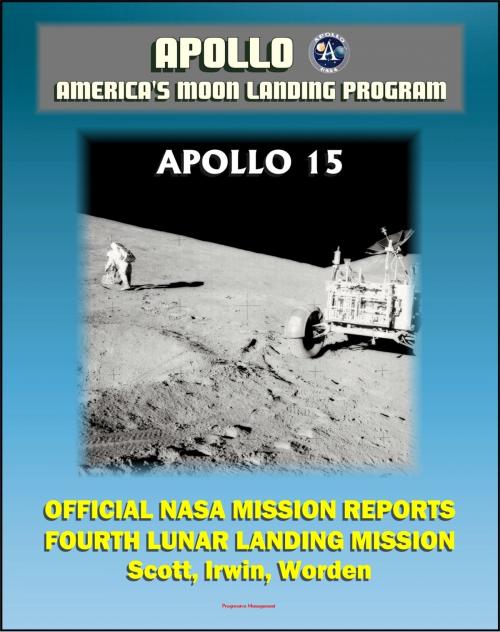Apollo and America's Moon Landing Program: Apollo 15 Official NASA Mission Reports and Press Kit - 1971 Fourth Lunar Landing, First with Lunar Roving Vehicle - Astronauts Scott, Irwin, Worden
Nonfiction, Science & Nature, Science, Physics, Astronomy, History, Americas| Author: | Progressive Management | ISBN: | 9781466134836 |
| Publisher: | Progressive Management | Publication: | November 29, 2011 |
| Imprint: | Smashwords Edition | Language: | English |
| Author: | Progressive Management |
| ISBN: | 9781466134836 |
| Publisher: | Progressive Management |
| Publication: | November 29, 2011 |
| Imprint: | Smashwords Edition |
| Language: | English |
Three comprehensive official NASA documents - converted for accurate flowing-text ebook format reproduction - chronicle the scientifically productive flight of Apollo 15, which was the first moon landing mission to use the LRV, or lunar rover.
Two technical mission reports, the Manned Spacecraft Center (MSC) Apollo Mission Report and the NASA Headquarters Mission Operation Report (MOR), provide complete details about every aspect of the mission.
Apollo 15 MSC Mission Report: Mission description, pilots' report, communications, trajectory, command and service module performance, mission support performance, assessment of mission objectives, launch vehicle summary, anomaly summary (CSM, LM, government furnished equipment), conclusions, vehicle descriptions. Apollo 15 MOR: Mission design and execution, spacecraft performance, flight anomalies, detailed objectives and experiments, launch countdown, detailed flight mission description, back contamination program, contingency operations, configuration differences, mission support, recovery support plan, flight crew, mission management responsibility, program management, abbreviations and acronyms. Apollo 15 Press Kit: Detailed preview from countdown to landing.
Apollo 15 was the first in a series of missions designed to conduct exploration of the moon over longer periods, greater ranges, and with more instruments for scientific data acquisition than on previous missions. Major modifications and augmentations to the basic Apollo hardware were made, the most significant being installation of a scientific instrument module in one of the service module bays, modification of the lunar module to carry a greater scientific payload and permit a longer stay on the lunar surface, and the provision of a lunar roving vehicle. The landing site chosen for the mission was an area near the foot of the Apennine Mountains and adjacent to Hadley Rille. The mission accomplished all of its objectives and is providing the scientific community with a large amount of new information concerning the moon and its characteristics.
Exploration and geological investigations at the Hadley-Apennine landing site were enhanced by the addition of the Lunar Roving Vehicle, or LRV. Setup of the Apollo Lunar Surface Experiments Package, or ALSEP, was the third in a trio of operating ALSEPs (on Apollos 12, 14 and 15). Orbital science experiments were concentrated in any array of instruments and cameras in the scientific instrument module, or SIM, bay. Engineering and operational objectives included evaluation of modifications to the lunar module, or LM, made for carrying a heavier payload and for a lunar stay time of almost three days. Changes to the Apollo spacesuit and to the portable life support system, or PLSS, were evaluated, and performance of the Lunar Roving Vehicle and the other new J-mission equipment that went with it -- lunar communications relay unit, or LCRU, and the ground-controlled television assembly, or GCTA.
Another major mission objective involved the launching of a Particles and Fields, or P&F, subsatellite into lunar orbit by the command and service module, or CSM, shortly before beginning the return-to-Earth portion of the mission. The subsatellite was designed to investigate the moon's mass and gravitational variations, particle composition of space near the moon and the interaction of the moon's magnetic field with that of Earth.
Three comprehensive official NASA documents - converted for accurate flowing-text ebook format reproduction - chronicle the scientifically productive flight of Apollo 15, which was the first moon landing mission to use the LRV, or lunar rover.
Two technical mission reports, the Manned Spacecraft Center (MSC) Apollo Mission Report and the NASA Headquarters Mission Operation Report (MOR), provide complete details about every aspect of the mission.
Apollo 15 MSC Mission Report: Mission description, pilots' report, communications, trajectory, command and service module performance, mission support performance, assessment of mission objectives, launch vehicle summary, anomaly summary (CSM, LM, government furnished equipment), conclusions, vehicle descriptions. Apollo 15 MOR: Mission design and execution, spacecraft performance, flight anomalies, detailed objectives and experiments, launch countdown, detailed flight mission description, back contamination program, contingency operations, configuration differences, mission support, recovery support plan, flight crew, mission management responsibility, program management, abbreviations and acronyms. Apollo 15 Press Kit: Detailed preview from countdown to landing.
Apollo 15 was the first in a series of missions designed to conduct exploration of the moon over longer periods, greater ranges, and with more instruments for scientific data acquisition than on previous missions. Major modifications and augmentations to the basic Apollo hardware were made, the most significant being installation of a scientific instrument module in one of the service module bays, modification of the lunar module to carry a greater scientific payload and permit a longer stay on the lunar surface, and the provision of a lunar roving vehicle. The landing site chosen for the mission was an area near the foot of the Apennine Mountains and adjacent to Hadley Rille. The mission accomplished all of its objectives and is providing the scientific community with a large amount of new information concerning the moon and its characteristics.
Exploration and geological investigations at the Hadley-Apennine landing site were enhanced by the addition of the Lunar Roving Vehicle, or LRV. Setup of the Apollo Lunar Surface Experiments Package, or ALSEP, was the third in a trio of operating ALSEPs (on Apollos 12, 14 and 15). Orbital science experiments were concentrated in any array of instruments and cameras in the scientific instrument module, or SIM, bay. Engineering and operational objectives included evaluation of modifications to the lunar module, or LM, made for carrying a heavier payload and for a lunar stay time of almost three days. Changes to the Apollo spacesuit and to the portable life support system, or PLSS, were evaluated, and performance of the Lunar Roving Vehicle and the other new J-mission equipment that went with it -- lunar communications relay unit, or LCRU, and the ground-controlled television assembly, or GCTA.
Another major mission objective involved the launching of a Particles and Fields, or P&F, subsatellite into lunar orbit by the command and service module, or CSM, shortly before beginning the return-to-Earth portion of the mission. The subsatellite was designed to investigate the moon's mass and gravitational variations, particle composition of space near the moon and the interaction of the moon's magnetic field with that of Earth.















